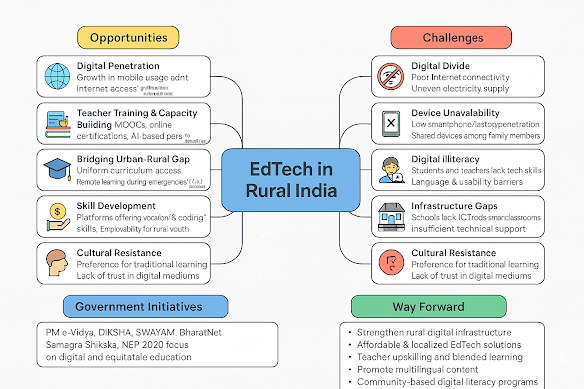"EdTech in Rural India – Challenges and Opportunities"
(GS2: Governance, GS3: Science & Technology, Education Sector)
Introduction
The COVID-19 pandemic accelerated the adoption of EdTech in India. However, its promise of democratising education is unevenly realised in rural India, where socio-economic and infrastructural barriers persist. Effective integration of EdTech can address learning gaps—but only if the foundational challenges are tackled.
Challenges in Rural EdTech Adoption
-
Digital Infrastructure Deficit
-
Only 31% of rural households have internet access (NSSO, 2021).
-
Power supply remains erratic, affecting device usage and online learning.
-
-
Device and Connectivity Gap
-
Lack of smartphones/laptops—especially among marginalised groups.
-
Gender divide in device ownership (ASER Report 2022: Girls lag behind boys in access).
-
-
Affordability Crisis
-
High data costs, platform fees, and device expenses exclude many from EdTech benefits.
-
-
Low Digital Literacy
-
Both teachers and students in rural India lack adequate digital skills.
-
-
Language and Cultural Mismatch
-
EdTech content is predominantly in Hindi/English, while many students speak local dialects.
-
-
Teacher Readiness
-
Training in digital pedagogy is limited; resistance to tech integration is common.
-
Opportunities in Rural EdTech Landscape
-
Democratisation of Quality Education
-
AI-based personalised learning (e.g., BYJU’S, Khan Academy) can bridge gaps in teacher quality.
-
-
Government Initiatives
-
PM e-Vidya, DIKSHA, SWAYAM, and BharatNet are expanding digital learning resources and rural broadband.
-
-
Cost-Effective Alternatives
-
Offline apps, radio/TV-based content, and local server-based platforms like Nalanda Project are bridging last-mile gaps.
-
-
Multilingual and Vernacular Content
-
EdTech platforms are evolving to offer regional language support, enhancing inclusivity.
-
-
CSR and NGO Participation
-
NGOs like Pratham, E-Vidyaloka, and CSR initiatives are delivering contextual, low-cost EdTech solutions.
-
Case Studies
-
Odisha’s Mo School Abhiyan: Leveraged alumni networks and tech platforms for rural school support.
-
Tamil Nadu’s Kalvi TV: Reached students through state-run TV during school closures.
-
Aspirational Districts Programme: Promotes digital infrastructure in underdeveloped rural areas.
Way Forward
| Priority Area | Strategic Action |
|---|---|
| Infrastructure | Fast-track BharatNet and promote solar-powered digital labs |
| Affordability | Subsidised device schemes and free data vouchers |
| Capacity Building | Digital pedagogy training for teachers |
| Inclusive Content | Vernacular, culturally-relevant materials |
| Hybrid Learning Models | Combine offline methods with digital content |
| Monitoring | Impact assessment and real-time data use in EdTech rollout |
Conclusion
EdTech is not a silver bullet but a powerful enabler. To ensure it bridges, not widens, rural educational divides, we need a contextual, inclusive, and participatory approach. Equitable access to digital learning must become a core pillar of India’s rural development and human capital strategy.
Possible UPSC Mains Questions:
-
GS2 (Governance): "Discuss the potential and limitations of EdTech as a tool for inclusive education in rural India."
-
GS3 (S&T): "Technology-led education can either bridge or widen the rural-urban gap. Discuss with reference to recent initiatives."

No comments:
Post a Comment